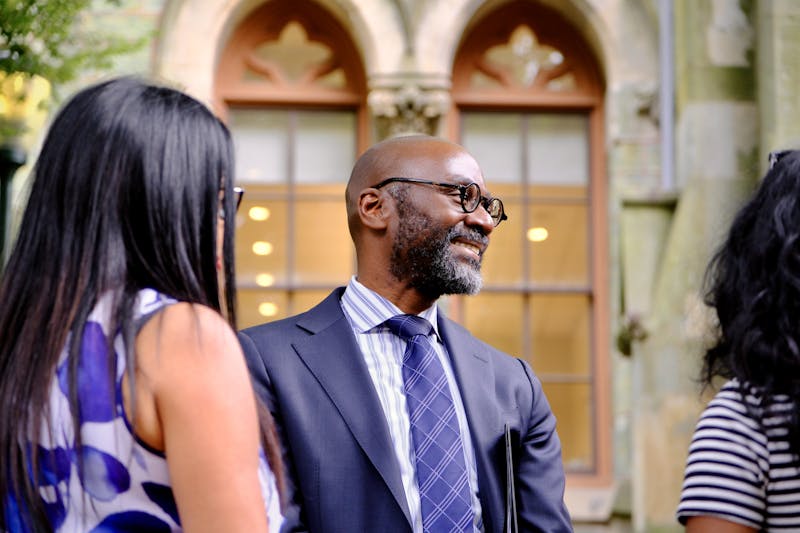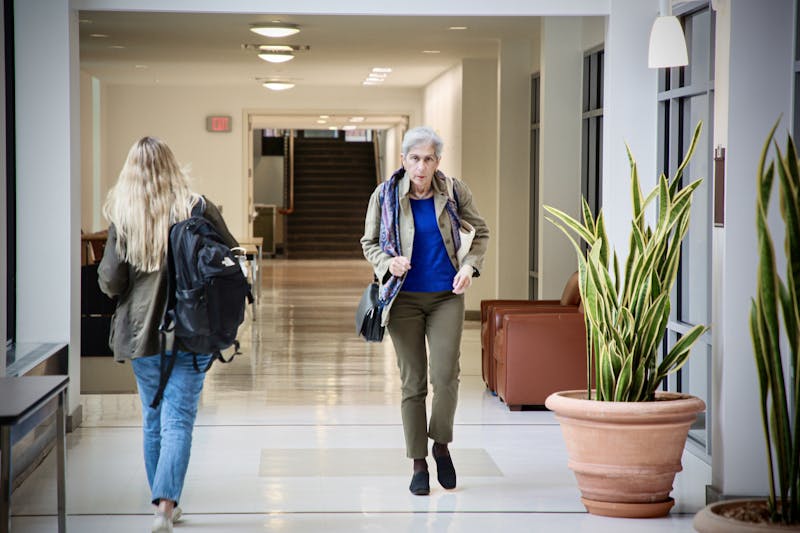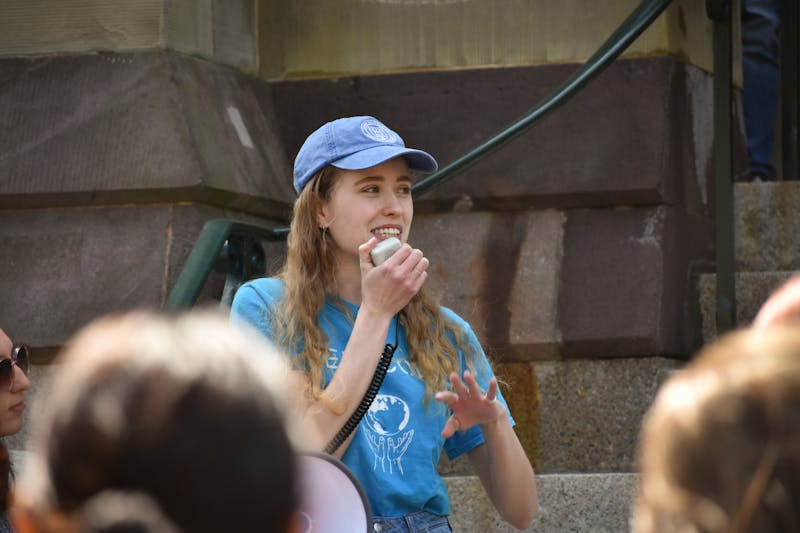
The first section of this article appeared in the May 31 issue of The Summer Pennsylvanian.
Bill Ayers bounced between conversations at Grant Park in Chicago on the afternoon of May 20 at one of the largest antiwar rallies in years.
The co-founder of the Weather Underground, the 1960s militant revolutionary group known for bombing public buildings, was donning a bright orange “Peace Guide” vest. He thumbed at three police officers walking by in descending rank. “He’s more responsible than him. And he’s more responsible than him. But he’s still responsible.”
The Occupy movement, which played an important role in this protest against the NATO summit, has had a rocky relationship with the police. The mainstream media has found a fascination with this tumultuous affair, turning the very real drama into a melodramatic reality show. Over the weekend, stories streamed about mass arrests and photos flowed of gashed foreheads, but protester’s actual experiences with these confrontations were scarcely mentioned.
Ayers refocused on me. “The only war heroes were people like my brother who deserted.… These veterans for peace, that’s who we should be saluting.”
And just a few hours later, the Iraq Veterans Against the War were honored as they led thousands of protesters and threw their medals over a fence in the direction of the NATO summit, an antiwar practice dating back to Ayers’ golden years.
Ayers’ views on the police were based on a philosophy that everybody is responsible for her actions. Doing what you’re told is no excuse, even if you’re in uniform. “Do I think we should therefore spit at them? No, I don’t,” he said. To him, cops are working-class people and the best tactic is recruitment.
“Sometimes that persuasion can be just a one-to-one conversation,” he offered. Protests in the 1960s demonstrated the impact of personal interaction. “When one or two or three soldiers broke ranks, the officers went crazy, because that’s the potential.”
For the rest of the weekend, I tried to pair my observations of the mass actions with personal conversations — on both sides. I spoke to police and protesters, removing the blue helmets and black masks, asking whether the police are part of the 99 percent or part of a police state in which violence is the closest one can get to “dialogue.”
From Saturday through Monday, I witnessed a true “diversity of tactics” toward the police, a common phrase used by activists as a reminder to respect each individual’s preferred mode of protest. At the anti-capitalist march on Saturday evening, I watched protesters use their hands to give the middle finger and peace signs, their bodies to block advancing lines of police on horseback and to pet those same horses and their voices to shout “Chicago to Greece, f*ck the police,” and “We are all 99 percenters.”
Even before speaking with Ayers, Saturday’s march tipped me off to Occupy’s internal tensions regarding the police. During a lull in the action, a man stood on a bench with a megaphone and began to preach: “The police are not our enemies.” Almost immediately he was drowned out by a chorus of “F*ck the police!” A minute later the megaphone was snatched from his hand.
While the chant that carried the evening was “Get those animals off those horses,” the push to humanize the cops was strong. It would become even more forceful when advanced by commanding spokespersons.
On Sunday afternoon, Vince Emanuel, a Marine Corps veteran against the war, stood on a stage overlooking a packed intersection and brought the microphone to his lips. “Our enemies are right here and we look at them every day. They are not the men and women who are standing on this police line,” pointing to the string of blue uniforms blocking the march’s advance towards the NATO summit. “They are the millionaires and billionaires who control this planet.”
While some dissenters booed at any call to respect police, the IVAW speakers were effective in lifting the scope away from the police and magnifying its hot light on the 1 percent.
Others were successful at cooling tensions through humor. Vermin Supreme, an activist known for running for office on platforms like zombie apocalypse awareness, attempted to calm the crowd as the IVAW ceremony ended. The black bloc, a group of confrontational anarchists wearing all black to conceal identities, moved towards the police line. Peaking out from under his signature boot-shaped hat, Supreme called for the immediate surrender of the Chicago Police Department and declared, “Your services are no longer required here, please return to your homes.”
The veterans’ attitudes quelled some, and the humorists’ mockery caught on with others, but intense arguments over police confrontation continued to pop up. Deep in the crowd, a black bloc protester on his way to the police barricade got snagged on a peacenik’s lines about nonviolence.
“Your peaceful bullshit … doesn’t work,” he spat out, arguing that peaceful protesters were trying to monopolize the demonstration. A small crowd gathered, but soon he was gone with the words, “It’s just dogmatic pacifism, bro.”
Monday’s protest shifted its gaze away from the police onto the issues of the political-economic system. Its route was thoughtfully planned, from Boeing International Headquarters to President Obama’s campaign headquarters — from the supplier to the buyer.
The protest was packed with fact-filled speeches, like a critique of Mayor Rahm Emanuel’s budget, which closed six of the city’s 12 mental health clinics.
Activists were successful at connecting these factual arguments with symbolic protest. Paper airplanes inscribed with peace messages whizzed past a speaker explaining the dangers of drones.
The exhibition at Boeing was successful in getting the aerospace and defense manufacturer to tell its employees to stay home. It even received Supreme’s stamp of approval: “They are violent and we are not. And we shut them down today creatively.”
While police presence was still impressive, an Occupy Chicago organizer could be seen working with police to arrange a convenient place for the protesters to eat lunch — quite a different feel and focus from Saturday and Sunday.
So what do these observations reveal about Occupy’s relationship with the police? Clearly, there is no consensus in Occupy on police confrontation and the divisions are often loud, visible and bitter. The focus on clashes with the police distract deeply from substantive messages and critiques, which Occupy can actually be very good at delivering under the right circumstances.
As Occupy nationalizes this summer (there will be a National Gathering in Philadelphia on July 4), the movement’s internal conflict over its relationship with the police presents a pronounced challenge. Occupy needs to address this and some — like veterans and humorists — are starting the conversation in a productive way.
When Occupy flows together, it can be diverted or displaced, but not divided. But this issue freezes Occupy — making it brittle and easy for its opponents to snap in half.
- * *
These observations showed that there is a conflict over police relations, but they cannot adequately explain why confrontational protest produces such bitter and intransigent disagreements among Occupiers — grabbing megaphones from one another, calling another activist’s tactics “bullshit.”
This issue demands such disproportionate attention that the movement seems nearly “preoccupied” with it. To understand why, I took Ayers’ advice and spoke to individuals on both sides of the Plexiglas police shields.
Marcus Bermudez-Deleon, a Northwestern University graduate and member of Occupy Chicago, got my attention when he summed up a point on violence: “Sometimes a ‘f*ck you’ will wake you up.” In my attempt to find theories on police conflict, I was attracted to Bermudez-Deleon’s (admittedly non-expert) conception of confrontation as a political tool that has more to do with the middle class than the police.
To Bermudez-Deleon, motivating the middle class requires taking away “those little things they think are success … that prefab house with the fence.” While a peaceful person, he posited that violence might be what is needed to get people “to leave their dinner tables.”
Besides rattling the middle-class cage, Bermudez-Deleon believed that violence could be empowering. He argued that most people think activism “doesn’t matter, because nothing is going to change.” But when masses push past police and take over public property, like the 50,000 student protesters did in the United Kingdom in 2010, it reminds an apathetic populace that the institutions of power belong to them.
Occupy Chicago member Joseph Harris, on the other hand, had a perspective similar to Ayers’ — emphasizing individual responsibility and character judgments. “We can love the police, but part of loving them is holding them accountable for what they do,” he said. “Police are people who have a hard job. Some are bad. Some are good.”
Harris tended to dislike the police, but it wasn’t personal. “I’m sorry the police are not my friends,” he said. “They work for the 1 percent.”
Although these were just two Occupiers, their approach to the subject was representative of my experiences with others — humble, thoughtful and reasonable. Occupy is a learning process for many. Activists often try to balance personal encounters with attempts at empathy when deciding which among the “diversity of tactics” to employ.
While I wasn’t able to interview any police officers, I tried to at least engage them. Results: No response. A shout to move. A smile.
When I asked one officer, “Do you know why there are horses?” pointing at the line of mounted cops pushing along any straggling activists, I finally got an answer. “Just to protect the people,” he replied. Ah.
On Sunday night, I finally got the one-to-one conversation that Ayers had prescribed. Just before midnight, police officers rushed to arrest someone in front of me, cutting a group of us off from the rest of the jail solidarity march. Two policemen told us we couldn’t rejoin the rally, so we struck up conversation.
My conversant was a middle-aged veteran who policed neighborhoods with heavy gang crime in Chicago. He remarked that if activists wanted change they should run for office — and then started boasting about his college-going son. Half an hour later, the police crossed the slick black street and hopped in their van, wishing us good night (calling me “buddy”) and snapping a photo with us.
The interaction was startlingly mundane. Which puzzled me even more. If the protesters are thoughtful and the police are sensible, then why is the relationship in such need of counseling?
Most people can understand why the police might get agitated after a while: Working overtime. Wearing heavy black equipment in the summer sun. Being taunted and teased (some protesters tried to “catch” police officers with donuts on fishing lines). Sometimes physically threatened. Surrounded by cameras to broadcast any mistake they might make to the world. If Ayers came up to me, I’d want to switch sides.
While the slice of police meat may be tough and chewy, it’s not dangerous to serve. But when the cook cranks the flame with spectacle-making media, douses on spicy anti-terrorist ideology and garnishes the dish with $1 million in riot equipment, the meat gets burned and the hungry guest gets indigestion — the only one safe is Chef 1 Percent.
- * *
While the public may appreciate what a protest looks like through a police visor, few attempt to understand the mindset of an Occupier.
In Chicago, the Occupied mind was in threat of a split-brain operation. The body of the movement was displaying epileptic fits, convulsing, around the issue of police confrontation. A desperate treatment for intractable seizures is to sever the corpus callosum — the fibers that connect the two sides of the brain — disrupting intra-brain communication. One hemisphere would wear black, fight blue and be drenched in red. The other would march carefully, speak softly and head home when the permit expires.
But what if these seizures are not biologically-based, inherent to the Occupied brain, but are psychologically-based, caused by stressful circumstances? Perhaps Occupy could ease these episodes (without any drastic procedures) by checking into psychotherapy. Then Occupy might recognize the external factors at work, stop internalizing these conflicts and be whole once more.
It’s not so hard to list the external circumstances fueling the police’s burning frustration, but what about the protesters? Their ire comes from an environment fear — the perceived War on Occupy.
- * *
“Is it cool if I use your bathroom?” It was noon on Saturday and a handful of weary activists lounging on church steps raised their brows at the young man pointing toward the entrance to the Convergence Center. “Why do you need to ask?” someone retorted. The young man fumbled for an explanation as he inched towards the bathroom. When he walked by, I noticed he had an amateur tattoo scribbled on his arm: “Occupy.”
The Wellington Avenue United Church of Christ served as a central meeting point for Occupiers throughout the weekend. It was the closest thing to a physical manifestation of the movement’s culture that I’d seen since the encampments were shut down in the fall.
Inside, duffle bags formed canvas hills, bodies of snoozing activists lay strewn across the floor, a piano’s melodies were accompanied with soft song and small groups busied themselves in the kitchen or sat huddled around laptops. It was lovely. But it wasn’t exactly welcoming.
Activist culture has long been caught in a conundrum. When a counterculture fears infiltration, solid values of openness, love, and community can melt to cover the floor in viscous globs of distrust and exclusivity, or burn up into a thick smog of suspicion and paranoia. Even the bladder-full young man’s politeness was perceived as dubious — despite his inked-skin credentials.
The arrests of the “NATO 3” pumped a fresh canister of fear into the atmosphere of the cluttered church. Reports have now come out that the three activists charged for terrorism, conspiracy, and possession of explosives had most likely been making beer (not bombs), had been entrapped by two informants whose violent suggestions they had rejected, and may have been targeted in connection with a YouTube video in which the three were being threatened by police.
But even before the National Lawyers’ Guild made such announcements, everyone knew. Some had been to the house and saw only beer-brewing machines, while friends of the arrested assured they were peaceful. In Chicago, this incident provided an opener to a much broader discussion about state repression and the War on Occupy.
And there’s a lot to discuss. The courts have been vindicating Occupier’s claims of innocence in a demonstrative manner — in Oakland, Los Angeles, Cincinnati, Charleston, and many other cities. New York City alone has seen three cases thrown out in the past few months, with several implications of police trumping up charges or arbitrarily arresting protesters. Allison Kilkenny, writing for The Nation, concluded: “It becomes clear there has been a systematic effort by police forces all across the country to stifle dissent, even if that means lying under oath in court.”
Investigations into the U.S. Department of Homeland Security has further exposed this coordinated national effort against Occupy. Dave Lindorff reported in CounterPunch that the Partnership for Civil Justice Fund secured documents, which reveal a vast intelligence network inundated with “anti-terrorism” funding.
National Director of PCJF Mara Verheyden-Hilliard claimed “Fusion Centers” have been used to mobilize local and federal officers to investigate the social justice movement, while a National Operations Center coordinates these missions across the country. This system disseminates contact information of activists that are charged with crimes as ludicrous as “using the sidewalk.”
While such factual revelations are legally important, Occupiers feel this war, not just know it. Many activists have personal stories of police repression and unlawful arrests that have been dismissed in court. And when informants and undercover cops are common, it’s no wonder many Occupiers feel suspicious, threatened and even vengeful against the privates in the War on Occupy.
But is it possible for Occupy to love the soldier and hate the war? And is that the best way to end it?
- * *
Ayers argued that the police are just “working class guys” doing their job. “So you can’t hate them personally, but you can hate what they’re doing.” They’re still responsible for their actions, but external circumstances shape that behavior. Similarly, the public should try to recognize the conditions that shape the Occupied mind, causing thoughtful individuals to feel passionately about confronting the police.
Emanuele pointed out that the real enemies of the 99 percent are the schemers, whose machinations push cops and protesters to fight — workers against workers. The statement by InterOccupy, a national communication group, on the NATO Protests highlights this point: “When real police oppression is happening, it becomes difficult to focus on the policies of NATO as the target of protest activities.” Which is what the so-called 1 percent wants: to distract and to divide.
For Occupy, this is a time of building. The stated goal of the 99 Percent Spring is to train 100,000 people in nonviolent action. Mass education can be an effective way to build a movement. Confrontation, at least at this stage in Occupy, seems more likely to push people away. One must respect the “diversity of tactics,” but violence has become the focus and is detracting from the spread of Occupy’s critiques, ideas and culture. And in this moment of intensive maturation for Occupy, stunted growth could have long-term effects.
The smog of the War on Occupy may make protesters and police alike swing blindly in fear and anger — but it’s more productive to look for the off-switch on the smog machine. Click. Now who turned that damn thing on in the first place?
Zachary Bell is a 2012 College graduate from New Haven, Conn. His email address is zacharyabell@gmail.com. Critical Playground appeared bi-weekly.
The Daily Pennsylvanian is an independent, student-run newspaper. Please consider making a donation to support the coverage that shapes the University. Your generosity ensures a future of strong journalism at Penn.
DonatePlease note All comments are eligible for publication in The Daily Pennsylvanian.







